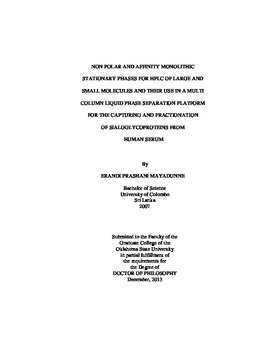| dc.contributor.advisor | El Rassi, Ziad | |
| dc.contributor.author | Mayadunne, Erandi Prashani | |
| dc.date.accessioned | 2015-06-17T20:06:54Z | |
| dc.date.available | 2015-06-17T20:06:54Z | |
| dc.date.issued | 2013-12 | |
| dc.identifier.uri | https://hdl.handle.net/11244/14993 | |
| dc.description.abstract | Scope and Method of Study: The major objective of this investigation was to develop novel nonpolar and affinity monolithic stationary phases for HPLC of small and large molecules, and the evaluation of their potentials in proteomics. The monolithic stationary phases were based on the in situ copolymerization of methacrylate/acrylate monomers in the presence of adequately chosen porogens. The nonpolar monoliths for reversed phase chromatography (RPC) involved the copolymerization of (i) octadecyl acrylate (ODA) and trimethyloyl propane triacrylate (TRIM) with or without incorporated multiwall carbon nanotubes (MWCNTs) and (ii) glyceryl methacrylate (GMM) and ethylene glycol dimethacrylate (EDMA) incorporated with MWCNTs. The affinity monoliths were based on the co-polymerization of GMM and pentaerythritol triacrylate (PETA) which were further modified with (i) surface immobilized lectins such as Sambucus nigra agglutinin (SNA) or Maakia amurensis lectin (MAL) and (ii) antibodies or microbial proteins for the depletion of high abundance proteins, e.g., albumin and immunoglobulins (Igs). These columns were assembled in a multi column platform consisting of high precision HPLC pumps and switching valves to perform the on line the depletion of albumin and Igs, followed by the capturing of sialoglycoproteins from human serum and the subsequent fractionation of these captured proteins by RPC. The RPC fractions were analyzed by liquid chromatography - tandem mass spectrometry (LC-MS/MS) to identify the sialoglycoproteins and to determine their differential expression in breast cancer serum with respect to disease free serum. | |
| dc.description.abstract | Findings and Conclusions: The major findings and conclusions were as follows: while GMM/EDMA-MWCNTs monolith proved useful for RPC separations of small chiral and achiral molecules on the basis of hydrophobic and pi-pi interactions, the ODA/TRIM monoliths with or without MWCNTs were very effective is separating proteins with improved selectivity when the monolith has incorporated MWCNTs. The lectin monolithic columns specific for sialoglycoproteins captured selectively these targeted proteins. These captured proteins, which were further fractionated by RPC, were readily identified by LC-MS/MS. In total, the multi column platform in combination with LC-MS/MS facilitated the identification of 71 differentially expressed proteins in breast cancer serum with respect to healthy serum, thus representing 71 candidate breast cancer biomarkers. | |
| dc.format | application/pdf | |
| dc.language | en_US | |
| dc.rights | Copyright is held by the author who has granted the Oklahoma State University Library the non-exclusive right to share this material in its institutional repository. Contact Digital Library Services at lib-dls@okstate.edu or 405-744-9161 for the permission policy on the use, reproduction or distribution of this material. | |
| dc.title | Non polar and affinity monolithic stationary phases for HPLC of large and small molecules and their use in a multi column liquid phase separation platform for the capturing and fractionation of sialoglycoproteins from human serum | |
| dc.contributor.committeeMember | Lavine, Barry | |
| dc.contributor.committeeMember | Materer, Nicholas | |
| dc.contributor.committeeMember | Bunce, Richard | |
| dc.contributor.committeeMember | Deng, Junpeng | |
| osu.filename | Mayadunne_okstate_0664D_13146.pdf | |
| osu.accesstype | Open Access | |
| dc.type.genre | Dissertation | |
| dc.type.material | Text | |
| thesis.degree.discipline | Chemistry | |
| thesis.degree.grantor | Oklahoma State University | |
